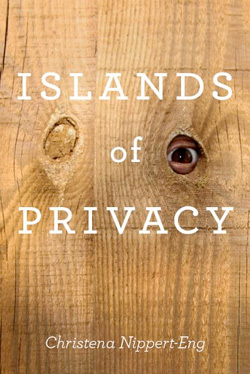These are things I know about people I have never met:
- Islands of Privacy by Christena Nippert-Eng. 360 pages. University of Chicago Press. $22.50.
I know a former writer for Jezebel accidentally left a tampon in for several days, and I know what the discharge looked like when she finally got it out.
I know what a memoirist and blogger ate today, and also what her cat looks like sitting up, lying down, chasing a bug, and hiding under the bed.
I know the sexual proclivities and preferences of a work colleague’s wife, because her husband announced them at a cocktail party. I was not at the party, but a friend called me mid-way through to relay the information.
I know about random people’s drug habits, eating disorders, cutting, menstrual cycles, and fetishes, because they wrote books about them and sent them to me. I know about their parents, too, because many writers are all too eager to dish family secrets, or even publish their parents’ diaries as soon as the rights fall into their hands. If there’s something missing from Christena Nippert-Eng’s examination of the boundaries between public and private life, Islands of Privacy, it’s an explanation for the people who feel comfortable sharing so much of their lives not just with the people around them but with the entire world.
Of course everyone has a line, and no one is willing to share absolutely everything. Nobody is announcing, say, a credit card number — the girl who loudly recites it over the phone, temporarily forgetting she’s on public transit, notwithstanding. What we consider to be acceptable to divulge might seem contradictory or bizarre because the line we refuse to cross is so deeply personal. The most intimate confessional blogger who has no problem relaying her sexual activity from the night before may also loudly protest when Facebook data mines her profile and messages for more targeted advertising. But each new violation of privacy quickly becomes the new norm — I remember when we learned that grocery chains were introducing membership cards for special discounts to collect information on their shoppers’ eating habits. Or when people realized Amazon was storing information about customers’ reading lists. These were met with outrage and protest. But now it seems so innocuous, now that we’ve gotten used to the trade off. We get cheaper milk and more accurate book recommendations out of the deal.
It’s how we decide what’s private, what’s important enough to us to keep quiet, that interests Nippert-Eng. Like the person who is willing to pay an extra 12 cents for peanut butter to avoid having her name linked to either Jiff or Skippy, or how people decide who is worthy of hearing their deepest darkest secrets. Of course it’s the violations of those privacy boundaries that make the best stories. Nippert-Eng relays large chunks of her interviews with Chicagoans (the focus of her research), and by far the most fascinating are those who suffered through identity theft, betrayal by their lovers, or, like the opening story, a mother of five whose privacy was so nonexistent that she couldn’t even find the time to change a tampon unobserved. Everyone loves a humiliating story, even when the entire point is how devastating the humiliation is.
Privacy maintenance is a process of daily negotiation, particularly for the urban dweller. Cities are invasive and nosy, and your personal space is constantly violated on the subway, the sidewalk, the elevator, the apartment building, the cubicle, the grocery store aisle… Daily life can turn into a long series of coping mechanisms. People may cite the widespread use of headphones, iPods, and cell phones as evidence that people don’t connect on a human level anymore, but in reality these are some of the few defenses the urban resident has. To be able to shut one off audibly makes so many of the other violations tolerable.
Although the most disturbing story in Islands of Privacy comes from a woman who moved to a city for the first time and found herself constantly being flashed — as in, that old story of the creepy man in the raincoat. She finally realized that she was somehow inviting this behavior simply by looking passersby in the face. There were enough perverts waiting for such an opening and expression of vulnerability to use the opportunity to reveal all. Once she developed the city “shell” that we all need to survive such close proximity, the flashings stopped.
The biggest disappointment about Islands of Privacy is that it does not delve into the vanishing line between private and public in the online world. While the book has a short chapter about e-mail and cell phones, and the nonchalance most people feel about the use of both until one little “Reply All” accident suddenly reveals way too much about us, it feels shallow. These privacy issues are becoming more and more pertinent, as college kids who thought nothing of having their picture taken while drunk/partially nude/passed out on the floor and posted on Facebook are now learning just how much a prospective employer can find out with a few keyword searches. And what about the unique problems of the online diarist, the memoirist, the personal essay writer, the blogger, and the unfortunate person who just happens to have the same name as someone who said, did, or blew up something embarrassing? Mistakes now live forever, and the ramifications are just begging to be explored. Nippert-Eng mostly skims past the issue, and so the online chapter is deeply unsatisfying.
Privacy is not simply about personal or financial safety, it’s about how we feel about the outside world. As a person with huge privacy boundaries, I look at the personal revelators and marvel at their comfort levels. If what we hide reveals what we value, what are we to think about the people who hide nothing but their social security numbers? • 3 November 2010




